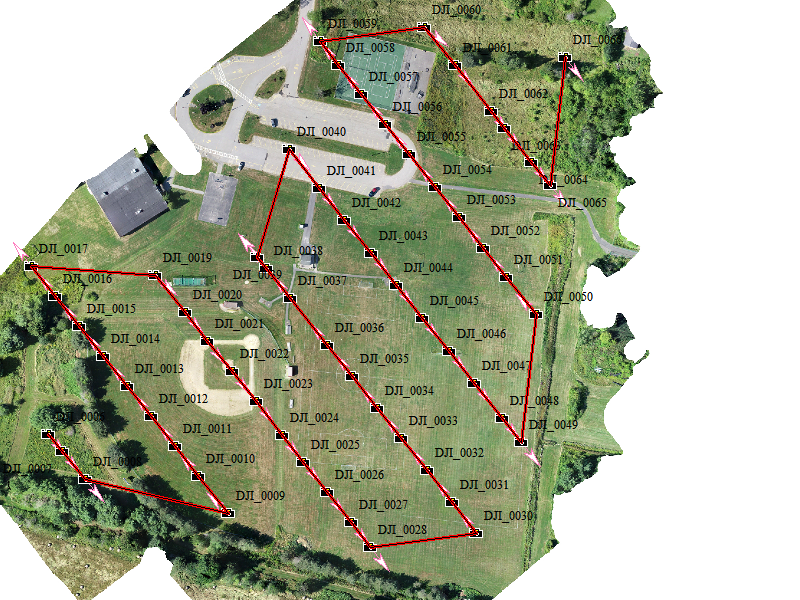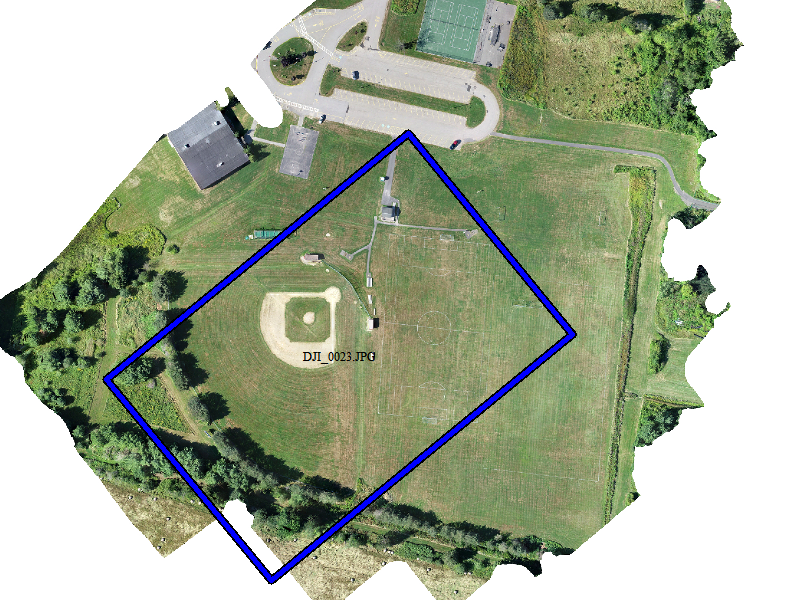The loaded images will be sorted based on the time stamp of the images. During the initial processing, all images are converted to JPG and copied to a temporary system file.
The input image file list will display information about each input image based on the metadata and EXIF tags (or imported positions) associated with the input files.
- Filename - input image file name, including the folder if it is stored in a subdirectory.
- Latitude, Longitude, Elevation - this information is obtained from the image metadata. The derivation of the elevation values can vary depending on the camera and collection platform.
- Relative Altitude - Relative Altitude may be used instead of elevation values using the Relative Altitude option. This attribute will only display for some imagery (DJI) .
- Fit Error- These statistics are reported once the tool has been run. This is the calculated minimum and maximum positioning error of the given image based on the auto-detected features in the image.
- # Observations - Once the tool has been run, each input image will display the number of identified matching features in each input image. These are the key points used in constructing the model.
- Image Size - The pixel dimensions of the input images
- Camera - The name of the camera used to collect the imagery. This value comes from the image metadata.
For drones with known low resolution positioning Global Mapper will show a warning alerting the user and asking if the EXIF tags should be ignored. Images from drones with low resolution positioning generally do not reconstruct unless ignoring the EXIF tags or updating the positions manually.
The Input images may appear blue or green when using Ground Control Points. See Ground Control Points with Pixels-to-Points™ for more information.
File Menu
The below options are available from the File Menu at the top of the Pixels to Points Tool dialog, or by right-clicking on the Input Image Files area. Image files may also be dragged and dropped into the Input Image Files area of the Pixels to Points tool from Windows.
Add Image File(s)... — Select image files to add to the input image files list. This list automatically filters to show just JPG, PNG and TIFF files. Use the SHIFT and CTRL keys to select multiple files to load from the file browser.
Add Folder... — Choose Add Folder to add all files from a directory.
Add Loaded Picture Points... — If the image files are already loaded into the main map view as picture points, use theAdd Loaded option to add them to the input image files list. If a subset of the picture points has been selected with the digitizer tool, an option will appear to add only the selected points. Press Yes to add only the pictures selected with the digitizer tool to the Input Image Files list. Press No to add all loaded picture points to the Input Image Files list.
Modify Camera Parameters - This tool lets you view and modify the database of camera parameters, including camera Sensor Width (mm) and Focal length (mm). The list includes Global Mapper's extensive Digital Camera Database and cameras supplied by the user. If images are loaded in the Pixels to Points dialog, the camera from the first image will automatically be selected in the list for easy editing.
Checking the Only Display Custom Camera Data box will show default cameras that have been edited by the user, and user supplied cameras.
This menu can also be accessed by right clicking on an image and choosing Edit Camera Settings.
Import Control Points from Loaded Point Layer... — If ground control points are already loaded in the main view, select this option and select the control point layer to load the points into the Pixels to Points dialog.
Load Control Points from Text File... — Select a text file to load control points from. This option will load a file of points previously saved from a Pixels to Points tool setup using the Save Control Points to Text File option, or a generic text file containing point features. When loading a text file of points you will need to set the generic text file import options as you would loading a text file into the Global Mapper main view. Pixels to Points supports orientation measured as Yaw/Pitch/Roll (YPR) and as Omega/Phi/Kappa (OPK). The Omega/Phi/Kappa angles are automatically converted to Yaw/Pitch/Roll during processing.
Load P2P Workspace File... — Select this option to load a saved Pixels to Points tool setup from a *.gmp2p or *.gmi2c file.
Save P2P Workspace File... — This option will save the Pixels-to-Points settings, input image references, and any added ground control points to a *.gmp2p file.
A *.gmp2p file is an ASCII based Global Mapper file that stores the settings, entered control points, and referenced image links specific to the Pixels to Points tool. The *.gmi2c file contains the same information and was exported from Global Mapper prior to v21.0; this format is also supported (only the extension is different).
Map Menu
The Map Menu contains various outputs that will load in the main Global Mapper map window.
Load Image(s) as Picture Point(s)
This option will add the images to the main map display as picture points. This will also display directional arrows indicating the orientation of the image, and a Flight Path line feature connecting the images in the order they were captured.
To adjust the location of a picture point, you can load the point(s) into the main workspace and move them using the Move tool. Moving an image point changes its EXIF information by default. These settings are found in Configuration under Raster Formats.
Load Ground Coverage Polygons for Selected Image(s)...
This tool will generate polygons approximately bounding the projected ground coverage of the selected input images. This allows you to approximate the alignment and overlap of the collected images.
Loading ground coverage polygons will generate an Overlap Statistics report in HTML format. This report will automatically open and will be saved at a temporary location. The report can be regenerated by choosing toLoad Ground Coverage Polygons again. For more information on this report seeImage Overlap Report.
Note: The ground coverage polygons will be different when generated before Pixels to Points has been run compared to those generated after the reconstruction has finished. This is because the Pixels to Points reconstruction process will refine the camera parameters and position.
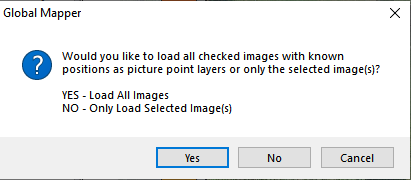
Choose to generate coverage polygons for all images loaded in the Pixels to Points tool by choosing YES, or choose NO to only load the highlighted image(s).
Specify the style of the ground coverage polygons. For more information on style options see Area Symbology.
Load Selected Image(s) as Orthoimage...
Automatically orthorectify the selected images. This tool works best after the Pixels to Points tool has been run, which creates a detailed surface model from the point cloud and also adjusts the camera position to fit the reconstructed scene.
For more information see Orthorectify Individual Images
Right-click Context Menu
These additional options are available by right-clicking on the Input Images Files list.
Load Image Positions from External File
This option can be used to add or update the positions of images based on an external text file.
Specify an external file that contains the camera position information. This should be a text format such as TXT or CSV and should be comma-delimited.
In addition to CSV and TXT, we now support PPK POSPAC files from Applanix (used by various drone hardware vendors)
The text file should contain the values of Filename/Index, Latitude, Longitude, Elevation. The values can be in this order, or the text file can contain a header row that uses recognized header labels to identify the appropriate columns:
| Values | Recognized Header Label (case insensitive) |
|---|---|
| Filename, Filepath or index number (starting at 1 or 0 for the first image in the Pixels to Points list which is sorted by the time stamp of the images) | Filename, FNAME, IMAGE, IMAGE_LINK, NR, Index, IDX |
| Latitude | Latitude, Lat, Y, Northing |
| Longitude | Longitude, Lon, X, Easting |
| Elevation | Z, Elev, Elevation |
When the operation succeeds you will see the following dialog.
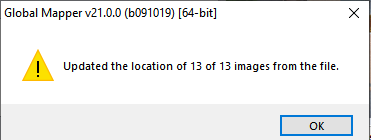
Remove Selected Images
Highlight images in the Input Image Files list, then press the Remove Selected button to delete the highlighted images from the input list. Use the SHIFT and CTRL keys to highlight multiple images.
Delete Disabled (Unchecked) Image Files...
This action will delete the original source image files that currently unchecked in the Input Image Files list. This can be used to clean out invalid images, such as blurry or close to the ground images, but should be used with caution.
Remove All Masks from Selected Images
When masks have been added, this operation will remove all masks and reset the Pixels to Points workspace back to using the full extent of all selected input images. See New Mask... for more information on image masks.
Show Image Metadata
This opens the metadata dialog for the selected picture point which includes information such as file path name, location, and projection. This is especially useful when the images are loaded as picture points and the Pixels to Points tool is needed for image display, as the user can view metadata without having to locate the image in the Control Center.
Camera Sensor Width
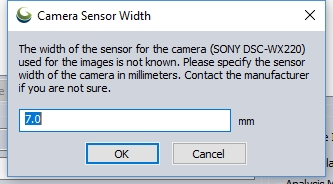
When loading images, if the image metadata indicates a camera not in the built in camera database or previously added, a dialog will appear asking for the sensor width. Check the manufacturer information for the appropriate value. The user added camera sensor width data is stored in the user data folder in a sensor_width_camera_database.txt file.
